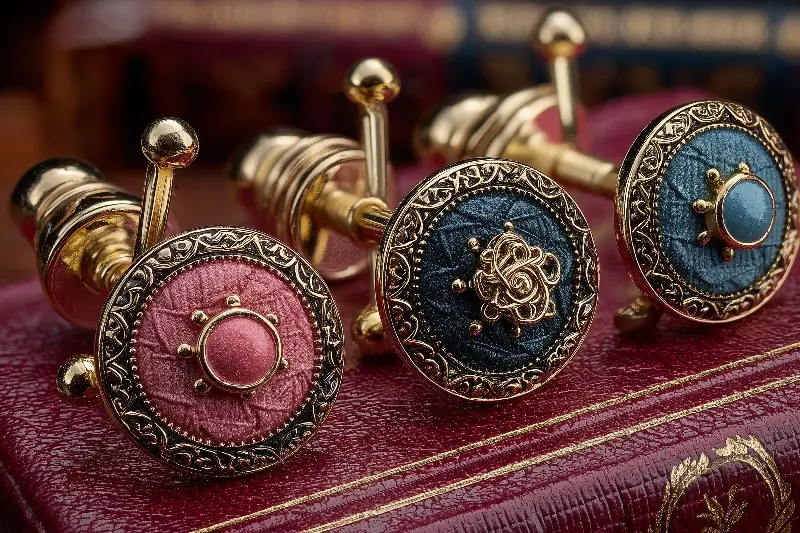Few accessories embody sophistication and quiet power quite like the cufflink. Beyond their practical function of fastening shirt cuffs, cufflinks have evolved into enduring symbols of status, taste, and refinement. Worn and cherished by kings, presidents, and style icons, their journey from necessity to luxury is a fascinating story woven into the fabric of fashion history.

From String To Silver: The Origins Of Cufflinks
The history of the cufflink begins not with precious metals or gemstones, but with simple ties of string or ribbon. In the early seventeenth century, when men’s shirts became more elaborate, the need arose for a more secure way to fasten cuffs. Before cufflinks, gentlemen would tie their shirt cuffs with small strings or use stitched-on buttons. However, as European fashion evolved through the 1600s, so did a desire for more elegant and decorative options.
It wasn’t until the late seventeenth century that the first true cufflinks started to appear. These early versions, known as "sleeve buttons," were typically made from gold or silver and often featured intricate designs. By the time of King Louis XIV’s reign in France, cufflinks had established themselves as a favored adornment among European nobility. Adorning one’s wrists with engraved gold or jeweled links quickly became a way to signal not only personal wealth, but also one’s place within elite circles.
A Reflection Of Power And Prestige
At their core, cufflinks have always been about more than just keeping cuffs tidy. They are wearable emblems of status, designed to catch the eye and convey success. During the Victorian and Edwardian eras, the accessory exploded in popularity as industrial advances made it possible to produce complex and artistic designs. Fine jewelry houses such as Cartier and Fabergé created bespoke cufflinks for aristocrats, often incorporating family crests, precious stones, or meaningful symbols.
In the twentieth century, the association between cufflinks and power became even more pronounced. World leaders, business tycoons, and Hollywood stars made the accessory a signature element of formalwear. Winston Churchill famously wore enamel cufflinks bearing his family crest, while President John F. Kennedy was regularly photographed wearing monogrammed sets gifted by his wife, Jacqueline. Such details transformed the humble cufflink into a subtle but unmistakable badge of authority.

Craftsmanship And Innovation
One reason cufflinks endure as fashion’s ultimate signifier of good taste is the artistry behind them. A true connoisseur’s collection might include hand-painted enamel designs, diamonds set in platinum, or unique custom commissions reflecting personal achievements or affiliations. In the golden age of cufflinks—the 1920s and 1930s—designers experimented with Art Deco, Art Nouveau, and even Surrealist influences, creating pieces that acted as tiny canvases on the wrist.
Interestingly, the evolution didn’t stop at materials and motifs. The mechanics, too, became a playground for innovation. From the simplest chain-links to intricate snap and swivel mechanisms, the way a cufflink operates is as much a part of its allure as its visible face. Today, advances in 3D printing and sustainable materials continue to push the boundaries, allowing for both tradition and cutting-edge creativity to coexist.
The Modern Cufflink: Style, Statement, And Individuality
Although men’s daily wardrobes have become more relaxed, the cufflink has proven its staying power by adapting to modern style sensibilities. Once reserved strictly for white tie or black tie events, cufflinks now regularly appear in business and casual settings alike. They’ve crossed gender boundaries, with women confidently sporting cufflinks as bold accents or homage to classic tailoring.
For many, personalizing cufflinks is a way to tell a story or share a passion. Monogrammed initials, emblems of alma maters, references to hobbies—like a pair in the shape of tiny guitars or cricket bats—all infuse the accessory with meaning. The re-emergence of vintage styles and retro designs, too, allows wearers to tap into nostalgia and history, complementing both contemporary and classic wardrobes.
While choosing the perfect cufflink comes down to occasion, taste, and mood, the effect remains the same: a small but striking detail that sets the wearer apart. In today’s world, where the line between formal and informal dress codes continues to blur, cufflinks serve as creative punctuation marks—design flourishes that communicate individuality and polish.
More Than Just Decoration: The Enduring Allure
What keeps cufflinks relevant after centuries of fashion evolution? It’s their unique ability to blend tradition with self-expression. Whether you’re drawn to vintage silver, avant-garde sculpture, or a whimsical design that sparks conversation, cufflinks tell the world that you care about the little things. They are tokens of achievement and taste, but also icebreakers at meetings or parties—a quiet nod to the art of dressing well.
Ultimately, the cufflink has transcended its original function to become much more than just an accessory. It is both a relic and a rebellious accent, equally at home on the wrist of a modern entrepreneur or a historical monarch. Small though they may be, cufflinks continue to wield a certain power—reminding us that elegance, after all, is found in the details.
